Do Wasps Make Honey?
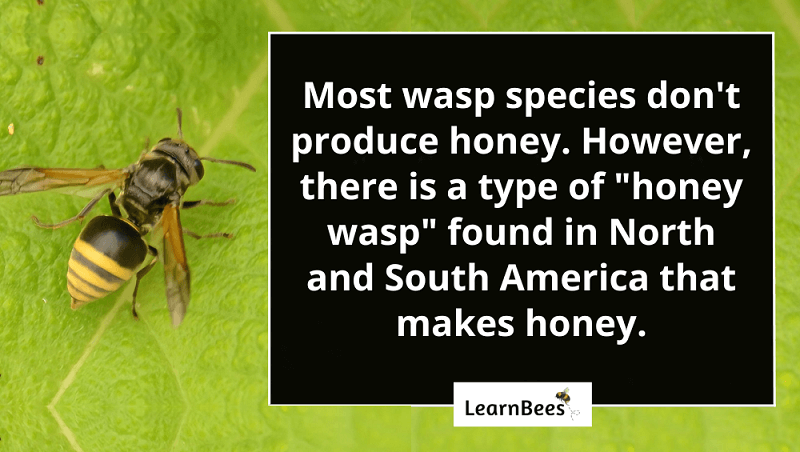
Honey wasps (Brachygastra) live in social colonies and produce honey just like honey bees do.
But here’s the thing:
Most wasp species don’t make honey.
Instead, wasps typically eat nectar and other insects, including caterpillars, beetles, and aphids.
But honey wasps are different.
Like honey bees, honey wasps use nectar from plants to produce honey. This honey allows them to survive during times when nectar sources are low, such as during summer droughts.
So, in a nutshell?
Honey serves as food storage for honey wasps.
The same is true for honey bees. Honey bees also eat honey during times of nectar dearth. In fact, honey bees share a lot in common with honey wasps.
For starters, both honey wasps and honey bees have predators who try to steal their honey.
Black bears are a prime example of this.

Black bears can smell food 18 to 20 miles away. This, of course, includes the honey produced by honey bees and wasps.(1)
The bad news?
A black bear can tear apart a honey wasp or bee nest in a matter of seconds. They grab chunks of the honey-filled nest while the wasps or bees are stinging them. Fortunately for bears, their coarse fur helps to protect them against stings.
Secondly:
Both honey bees and honey wasps lose their stingers after stinging.
This is because they have barbed stingers with small “hooks” on them. The hooks get lodged into human skin and stuck, leaving the stinger behind when they fly away.
And as you may have guessed:
Losing their stinger is a death sentence for honey bees and honey wasps.
Their stinger is attached to vital organs. Once it’s pulled out, many of the insect’s essential organs are too.
Now that brings us to our next question…
Can You Eat Wasp Honey?
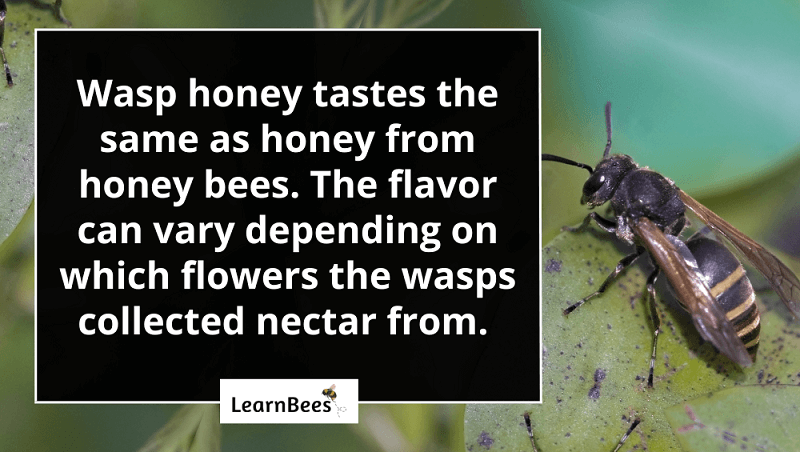
“What does wasp honey taste like?” is a common question.
Wasp honey is both edible and delicious. The texture, scent, and flavor are similar to the raw honey made by honey bees.
But keep in mind:
The flavor of honey depends on which plants the wasps collected nectar from.
For instance, wasps that gather nectar from orange trees produce orange blossom honey. Orange blossom honey has a sweet and delicate flavor with light citrus undertones.
On the other hand, blueberry wasp honey has a sweet taste with hints of berries.
But here’s the thing:
Most people never taste wasp honey because it isn’t produced on a large scale like honey from honey bees is.
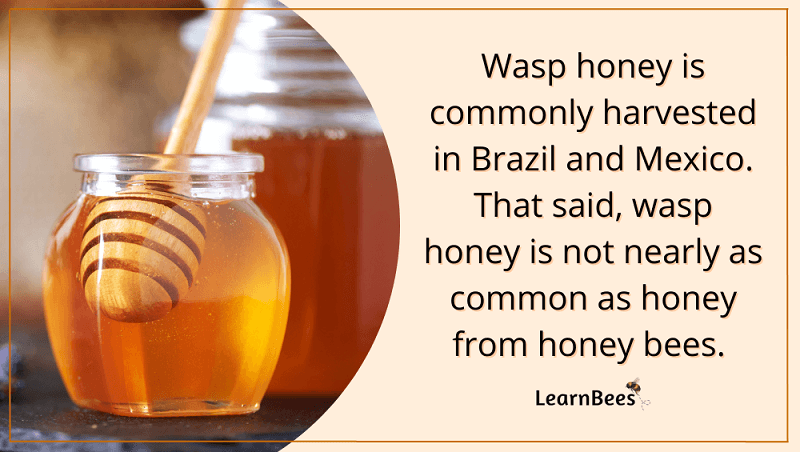
This is because honey wasps live in smaller colonies and have only been discovered in North and South America.
In contrast:
Honey bees are found on every continent except Antarctica. They can produce dozens of pounds of honey per year.
That said, honey from wasps is sometimes collected in Brazil. Brazilians harvest the honey by collecting the honey-filled nest. If the base of the nest is left behind, then the honey wasps will rebuild their nest in the same place.
The same is true in Mexico.
Wasp farmers collect honey wasp nests and move them to places where they’re easy to access and harvest honey from. From there, wasp farmers sometimes even sell the honey.
Why Do Wasps Make Honey?
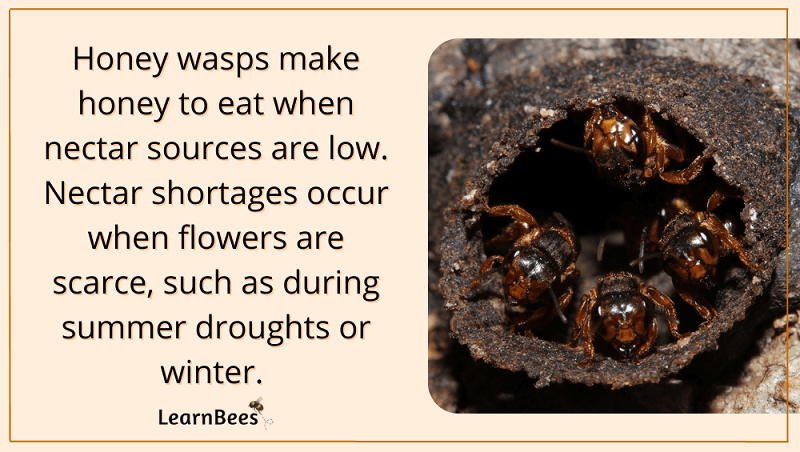
Wasps make honey for the same reason bees do:
For food.
More specifically, honey is food storage during flower nectar shortages. This includes summer droughts that kill flowers and winter months when plants go dormant.
But remember:
Not all wasps and bees make honey.
In fact, there are over 20,000 different bee and wasp species, and most of them don’t produce honey. This is one thing that makes honey bees, bumble bees, and honey wasps unique. They make honey so they can survive times of food shortages.
Not all honey is created equally, though.
As mentioned, honey bees are the only insect that produces honey on a mass scale. A healthy honey bee colony can make upwards of 50 pounds of honey per year.
But keep in mind that honey bee colonies are huge. They can contain over 60,000 honey bees in a single hive, all working together to produce honey.
Compare that to honey wasps.
Honey wasps live in social colonies of usually no more than 15,000 wasps.
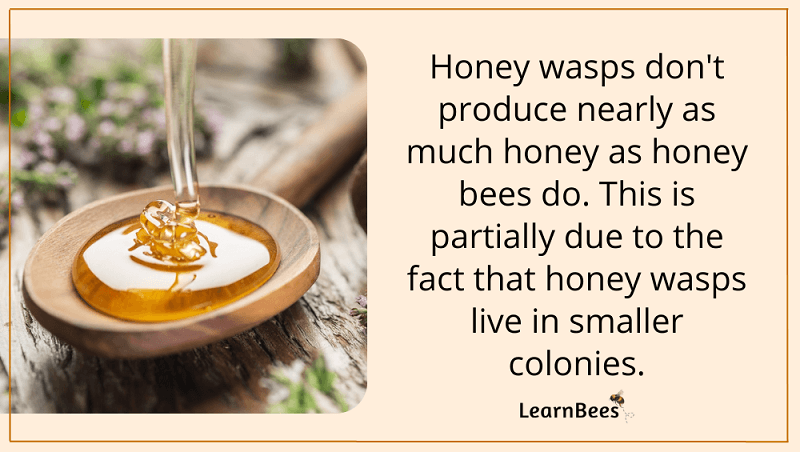
Don’t get me wrong, 15,000 wasps is still a large colony. However, it’s nowhere near the size of honey bee nests. So, in short, honey bees have more helping hands necessary to produce honey on a large scale.
Additionally:
Honey wasps are native to warmer climates, such as the southwestern United States and South America. Warm climates offer more flowers and nectar resources, so producing large amounts of honey isn’t always necessary.
In contrast, honey bees are found everywhere except Antarctica. They’ve adapted to hot and cold climates, and beekeeping has become popular worldwide.
What’s more, honey bees are genetically programmed to produce more honey than they need.
In other words?
Honey bees would rather be safe than sorry.
This is where beekeeping comes in. Beekeepers harvest the surplus honey that honey bees produce, ensuring that they leave enough for the bees to eat during the winter.
In turn, honey from honey bees is both produced and sold on a large scale. It’s estimated that the honey industry has a market size of 9 billion dollars.
FAQs on “Do Wasps Make Honey?”
- Do wasps make honeycomb?
- What color is wasp honey?
- What is the texture of wasp honey?
- Can you eat wasps honey?
- Do wasps turn nectar into honey?
- Do wasps turn pollen into honey?
- How long does it take wasps to make honey?
- Do predators eat wasp honey?
- What does wasp honey taste like?
- Do people collect honey from wasps?
Do wasps make honeycomb?
Honey wasps create a honeycomb-like structure that has hexagonal cells to hold honey. However, it’s not an actual honeycomb in the same way that honey bees produce it.
A honeycomb is made of beeswax by honey bees.
Honey bees secrete the wax from eight wax-producing glands on their abdomen. Beeswax is used to store both honey and bee larvae.
Contrastly, wasps create nests using wood fiber from trees, shrubs, logs, and fences.
The wasps scrape wood fiber from wood sources and chew it to combine it with their saliva. In turn, this creates a paper-like pulp. The wasps then spit out the pulp and shape it into hexagonal cells.
As the pulp dries, it creates a sturdy paper nest where the young honey wasps develop into adult wasps. Some wasp species also may use dirt or mud to strengthen the structure of their nest.
As the wasp colony grows in population, the queens and workers continue to add new hexagonal cells to the nest to handle the growing population.
—> Go back to the FAQs on “Do Wasps Make Honey?”
More to Explore:
- Do Wasps Make Honey?
- What’s the Difference Between Wasps, Hornets, and Bees?
- Wasp Nest vs. Bee Nest: Which One Is It?
What color is wasp honey?
Like honey from honey bees, wasp honey can vary in color depending on where the wasps collected the nectar. The color of honey can be nearly translucent to dark brown.
As a rule of thumb, darker honey tends to be bold and strongly flavored. It’s usually not as sweet as milder, light forms of honey. Many people compare the taste of dark honey to molasses. But again, this just depends on which plants the wasps collected nectar from.
Remember:
Both honey wasps and honey bees turn nectar from flowers into honey.
It begins with adult honey wasps using their long tongues to suck the nectar out of flowers. Nectar is the reward plants create to entice pollinators to their flowers. Nectar is “the energy drink” of the insect world, providing wasps and bees with carbohydrates.
Once the honey wasps collect the nectar, they store it inside an internal organ called the “honey crop.” During this process, the nectar gets mixed with special enzymes from the wasps’ salvia. These unique enzymes begin the honey-making process.
From there, the wasps bring the nectar back to the nest so the other adult wasps can continue turning it into honey. Honey is comprised of glucose and fructose, which are natural sugars that give honey its sweet taste.
—> Go back to the FAQs on “Do Wasps Make Honey?”
More to Explore:
What is the texture of wasp honey?
Wasp honey has the same texture as honey from honey bees. It’s a sticky, syrup-like texture. Some people describe it as a mix of liquid and dense because it’s not as runny as water, but it’s not as solid as other foods.
If you pour wasp honey onto a spoon, it’ll drizzle off slowly.
Additionally, wasp honey can crystallize just like honey from honey bees. Honey crystallizes due to its high sugar content and low water content. Honey is made up of only about 20% water, which isn’t enough water to keep the sugar dissolved long-term.
So eventually, all raw honey forms tiny sugar crystals over time. Some honey crystals are large and gritty, while others are fine and smooth.
But don’t worry.
Crystallized honey is still safe to eat. It’s just liquid honey that has turned solid over time. It can be turned back into liquid honey by heating and stirring it.
—> Go back to the FAQs on “Do Wasps Make Honey?”
More to Explore:
Can you eat wasps honey?
“Is wasp honey edible?” is a common question.
The answer is yes; you can eat wasp honey. But it’s important to note that wasp honey is tough to get your hands on. The raw honey you find at the store comes solely from honey bees – not other bee species or wasps.
Wasp honey is most commonly harvested in Brazil and Mexico since honey wasps are more commonly found there.
But honey wasps produce a tiny amount of honey compared to honey bees.
That said, wasp honey is safe to eat and tastes the same as honey from honey bees. It may have a slightly different flavor profile depending on the nectar sources the wasps collect from. But overall, you wouldn’t be able to tell the difference.
—> Go back to the FAQs on “Do Wasps Make Honey?”
More to Explore:
Do wasps turn nectar into honey?
Yes, like honey bees, honey wasps turn nectar from flowers into honey.
It starts with adult wasps using their long tongues to suck the nectar out of flowers. Nectar is the sugary liquid plants create to attract pollinators to their flowers. Nectar is “the energy drink” of the insect world, providing wasps and bees with the carbs they need.
—> Go back to the FAQs on “Do Wasps Make Honey?”
More to Explore:
Do wasps turn pollen into honey?
No, pollen doesn’t get turned into honey. Nectar and honeydew are what honey wasps and bees use to produce honey.
—> Go back to the FAQs on “Do Wasps Make Honey?”
More to Explore:
How long does it take wasps to make honey?
It’s hard to say how long it takes honey wasps to produce honey because we don’t have the research yet. That said, honey wasps start building their nest, laying eggs, and creating honey as soon as they emerge in the spring.
—> Go back to the FAQs on “Do Wasps Make Honey?”
More to Explore:
Do predators eat wasp honey?
Honey wasps don’t make as much honey as honey bees, but they’re still targeted for the honey they produce. Bears and other insects are typical examples of the honey-loving predators they face.
—> Go back to the FAQs on “Do Wasps Make Honey?”
More to Explore:
- Ground Bees: Are They a Threat to Your Yard?
- Wasps vs. Honeybees: Are They Different?
- Do Bumble Bees Bite?
What does wasp honey taste like?
Wasp honey tastes the same as honey from honey bees.
—> Go back to the FAQs on “Do Wasps Make Honey?”
More to Explore:
Do people collect honey from wasps?
Yes, people living in Brazil and Mexico are known for collecting wasp honey. But it’s important to note that wasp honey is tough to get your hands on. The honey you find at the store is made by honey bees.




